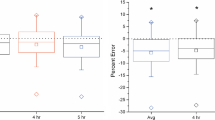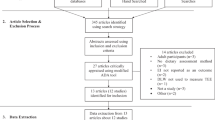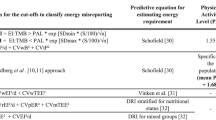Abstract
Objective: To evaluate whether the doubly labeled water (DLW) method is precise under conditions required for a large-scale evaluation of dietary intake instruments.
Design: Energy expenditure was measured in 484 subjects (main study). Subjects received one of five different weight DLW dose bottles prepared in advance of the study. A repeat energy expenditure measure was obtained in a subset of 24 subjects (substudy). DLW measures of energy expenditure were performed over a 2-week interval with urine collection at the beginning and end.
Setting: Free-living environment with three clinic visits in the Maryland suburban area of Washington, DC.
Subjects: A total of 484 subjects (261 men and 223 women) aged 40–69 y, 24 of whom (13 men and 11 women) participated in a substudy in which DLW was administered a second time.
Results: The coefficient of variation of the DLW energy expenditure measurement was 5.1%. This included a 2.9% analytical and a 4.2% physiologic variation. Based on observed initial isotopic enrichment, the preweighed dosages were optimal in 70% of the main study subjects, and 9% received a dose that was less than optimal. Only six subjects (1%) were excluded because the final isotopic enrichment was too low to conduct precise measurement.
Conclusions: Use of preweighed DLW dosages did not compromise the precision of the DLW method. The DLW method is a reliable measure of energy expenditure for large-scale evaluations of dietary intake instruments.
Sponsorship: The National Cancer Institute.
This is a preview of subscription content, access via your institution
Access options
Subscribe to this journal
Receive 12 print issues and online access
$259.00 per year
only $21.58 per issue
Buy this article
- Purchase on Springer Link
- Instant access to full article PDF
Prices may be subject to local taxes which are calculated during checkout


Similar content being viewed by others
Notes
Permil is a one part per thousand (‰) change in the ratio of the heavy to light isotope—that is (Rsample/Rstandard−1) × 1000, where R is the molar ratio of the heavy (2H) to light (1H) isotope abundance. A 1 permil change in 18O or 2H enrichment corresponds to the addition of 2 mol of 18O-hydride or 0.16 mol 2H oxide to 106 mol of water, respectively.
References
Beaton G, Milner J, Corey P, McGuire V, Cousins M, Stewart E, deRamos M, Hewitt D, Grambsch P, Kassim N & Little J (1979): Sources of variance in 24-hour dietary recall data: implications for nutrition study design and interpretation. Am. J. Clin. Nutr. 32, 2456–2559.
Blanc S, Colligan A, Trabulsi J, Harris T, Everhart J, Bauer D & Schoeller DA (2002): Influence of delayed isotopic equilibration in urine on the accuracy of the 2H218O method in the elderly. J. Appl. Physiol. 92, 1036–1044.
Brun T, Bleiberg F & Goihman S (1981): Energy expenditure of male farmers in dry and rainy seasons in Upper-Volta. Br. J. Nutr. 45, 67–75.
Calazel C, Young V, Evans W & Roberts S (1993): Effect of fasting and feeding on carbon dioxide production using doubly labeled water. J. Appl. Physiol. 74, 1824–1829.
Cole T & Coward W (1992): Precision and accuracy of doubly labeled water energy expenditure by multipoint and two-point methods. Am. J. Physiol. 263, E965–E973.
Goran M, Beer W, Wolfe R, Poehlman E & Young V (1993): Variation in total energy expenditure in young healthy free-living men. Metabolism 42, 487–496.
Goran M, Nagy T, Gower B, Mazariegos M, Solomons N, Hood V & Johnson R (1998): Influence of sex, seasonality, ethnicity, and geographic location on the components of total energy expenditure in young children: implications for energy requirements. Am. J. Clin. Nutr. 68, 675–682.
Horvitz M & Schoeller DA (2001): Natural abundance deuterium and 18-oxygen effects on the precision of the doubly labeled water method. Am. J. Physiol. 280, E965–E972.
Hunt W, Leonard A, Garry P & Goodwin J (1983): Components of variance in dietary data for an elderly population. Nutr. Res. 3, 433–444.
Luke A & Schoeller DA (1997): Rapid 18O analysis of CO2 samples by continuous-flow isotope ratio mass spectrometry. J Mass Spectrom. 32, 1332–1336.
Racette S, Schoeller DA, Luke A, Shay K, Hnilicka J & Kushner R (1994): Relative dilution spaces of 2H- and 18O-labeled water in humans. Am. J. Physiol. 267, E585–E590.
Ritz P, Johnson P & Coward W (1994): Measurements of 2H and 18O in body water: analytical considerations and physiological implications. Br. J. Nutr. 72, 3–12.
Roberts S, Dietz W, Sharp T, Dallal G & Hill J (1995): Mulitple laboratory comparison of the doubly labeled water technique. Obes. Res. 3, 3–13.
Schoeller DA (1983): Energy expenditure from doubly labeled water: some fundamental considerations in humans. Am. J. Clin. Nutr. 38, 999–1005.
Schoeller DA (1988): Measurement of energy expenditure in free-living human beings by using doubly labeled water. J. Nutr. 118, 1278–1289.
Schoeller DA (1996): Hydrometry. In Human Body Composition. eds Roche, AF, Heymsfield SB & Lohman TG, pp 25–43. Champaign: Human Kinetics.
Schoeller DA, Colligan AS, Shriver T, Hargish H & Bartok-Olson C (2000): Use of an automated reduction system for hydrogen isotope analysis of physiologic fluids applied to doubly labeled water. J. Mass Spectrom. 35, 1128–1132.
Schoeller DA & Hnilicka J (1996): Reliability of the doubly labeled water method for the measurement of total daily energy expenditure in free-living subjects. J. Nutr. 126, 348S–354S.
Schoeller DA, Leitch C & Brown C (1986): Doubly labeled water method: in vivo oxygen and hydrogen isotope fractionation. Am. J. Physiol. Regul. Integr. Comp. Physiol. 251, R1137–R1143.
Schoeller DA, Taylor P & Shay K (1995): Analytical requirements for the doubly labeled water method. Obes. Res. 3, 15–20.
Subar AF, Kipnis V, Troiano RP, Midthune D, Schoeller DA, Bingham S, Sharbaugh C, Trabulsi J, Runswick S, Ballard-Barbash R, Sunshine J & Schatzkin A 2003, in press: Using intake biomarkers to evaluate the extent of dietary misreporting in a large sample of adults: The Observing Protein and Energy Nutrition (OPEN) study.
Weir J (1949): New methods for calculating metabolic rate with special reference to protein metabolism. J. Physiol. 109, 1–9.
Author information
Authors and Affiliations
Corresponding author
Rights and permissions
About this article
Cite this article
Trabulsi, J., Troiano, R., Subar, A. et al. Precision of the doubly labeled water method in a large-scale application: evaluation of a streamlined-dosing protocol in the Observing Protein and Energy Nutrition (OPEN) study. Eur J Clin Nutr 57, 1370–1377 (2003). https://doi.org/10.1038/sj.ejcn.1601698
Published:
Issue Date:
DOI: https://doi.org/10.1038/sj.ejcn.1601698
Keywords
This article is cited by
-
An objective measure of energy intake using the principle of energy balance
International Journal of Obesity (2021)
-
Adult energy requirements predicted from doubly labeled water
International Journal of Obesity (2018)
-
The association of change in physical activity and body weight in the regulation of total energy expenditure
European Journal of Clinical Nutrition (2017)
-
Inter- and intraindividual correlations of background abundances of 2H, 18O and 17O in human urine and implications for DLW measurements
European Journal of Clinical Nutrition (2015)
-
Using doubly labeled water to validate associations between sugar-sweetened beverage intake and body mass among White and African-American adults
International Journal of Obesity (2014)



